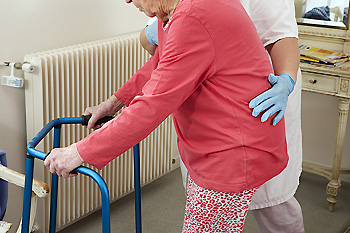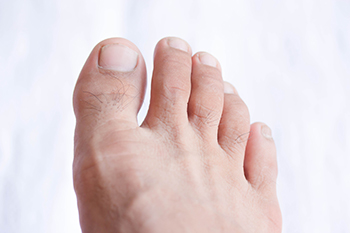Falls are a leading cause of serious injury among the elderly. In fact, falls are the cause of the majority of hospitalizations for elderly people. As we age, our risk of falling increases due to deterioration in physical strength, coordination, vision, and hearing. Unsafe conditions in the home are often responsible for falls, and about half of all falls among the elderly occur in the home environment. Falling can cause a variety of complications, including injuries to the legs and feet, which can greatly impact one’s mobility and independence.
Fortunately, falls can often be prevented. There are various preventive measures that you can take to make your home environment safer and less likely to contribute to a fall. In the bathroom, where wet and slippery conditions can lead to falling, it is recommended that you have non-slip surfaces in the shower and tub, install grab bars by the toilet and bath to help you sit and stand, and wipe up any moisture or spills as soon as they occur. In the living room and bedroom, it is important to make sure that the floor is free of clutter and obstacles, such as loose cords and wires, small furniture items, and other tripping hazards. Ensure that all rugs and mats are firmly anchored and that there is good lighting throughout the home. In the kitchen, it is suggested that you store appliances and other supplies in places that are easy to reach and that you wipe up any spills that may occur immediately. If your home has stairs, they should be well lit and have secure handrails.
You can also prevent falls by modifying your own behavior. When moving around the home, walk slowly and carefully, turn on lights when walking through your home at night, and use any mobility aids, such as a cane or walker, when needed. Exercise regularly and eat a healthy diet to maintain your overall health. Speak regularly with your doctor to monitor your medications, especially if you are taking any medications that may increase your risk of falling due to side effects such as dizziness. For more tips on how to prevent falls, please consult with a chiropodist.

Senior citizens ought to be taking extra special care of their feet. One of the reasons for this is that seniors might have certain afflictions of the feet that weaken their strength. As a result, falling might be more likely, which can bring on its own host of health problems and complications. There are many ways that a senior citizen might go about preventing falls. Importantly, a senior might consider being more careful when rushing to complete a task around the house. If a senior is late in leaving the home or has to hurry to a particular room in the house to complete a task, their likelihood of falling might increase. When seniors are rushing and hurrying around the house, they are not as careful and mindful of how they are moving their feet. Therefore, reducing the extent to which you rush around the house might yield beneficial outcomes for your foot health. Contact a chiropodist today for more information.
Falls are a major cause of injury among the elderly. To learn more about preventing falls or to get treatment following a foot or ankle injury caused by a fall, please consult with one of the chiropodists from The Footcare Centre. Our chiropodists will assess your condition and provide you with quality foot and ankle treatment.
Falling is one of the leading causes of injury among the elderly. It is said that about 50% of falls that result in hospitalization occur in the home. Fortunately, there are steps that you can implement to reduce your risk of falling in the home.
Tips to Prevent Falls at Home:
In the bathroom - Place non-slip mats in the shower or tub, install grab bars near the toilet and bath, and wipe up any moisture or spills as soon as possible.
In the living rooms and bedroom - Remove loose wires, cords, or other objects that may be an obstacle to moving around safely. Make sure that you have good lighting throughout the home so that you can always see where you are going. Get rid of any rugs or mats that are not firmly anchored or that may cause you to trip. When walking around the home, move slowly.
In the kitchen - Store food and supplies in easily accessible areas, store heavy items in lower cupboards, and wipe up any spills immediately to prevent slipping.
On the stairs - Make sure that the stairs are well-lit and have secure handrails. Walk slowly when ascending or descending the stairs.
Outside - Keep walkways well-lit and clear of snow, ice, leaves, and man-made tripping hazards.
Maintaining your overall health, including the health of your feet, can also help to prevent falls. Eat a healthy diet, exercise regularly, and wear well-fitted, comfortable, and supportive shoes. If you have a mobility device, such as a cane, use it while walking.
If you have any questions, please feel free to contact our office located in . We offer the newest diagnostic and treatment technologies for all your foot care needs.
Foot biomechanics is an area of foot care that examines the structure, function, and motion of the feet. When these factors are carefully examined, they can provide more information about potential causes of foot and ankle pain and help your chiropodist find the best treatments for the unique needs of your feet.
The study of biomechanics dates back to ancient times but became more well known in modern history when findings claimed that changing or controlling the forces between the ankle and foot can lead to positive clinical outcomes when treating various foot and ankle conditions.
The advent of modern technology, such as computer analysis, has continued to expand on these discoveries and helps medical professionals make informed decisions about patient care. Understanding the biomechanics of the feet can help in the diagnosis of various conditions and prescribing targeted treatments that reduce or eliminate pain. For example, a chiropodist can analyze your gait, or walking pattern, and determine if there are any abnormalities that can be treated with custom orthotics or footwear modifications.

The toenails are a seemingly small and insignificant part of the feet. However, they are, in fact, incredibly important and play a significant role in daily human activity. The toenails serve a variety of different functions. Importantly, the nails help humans protect their toes against injury. The toes, since they are engaged in so much constant motion, are susceptible to injuries like scrapes and cuts. However, the toenails essentially guard the tips of the toes against these injuries. Also, the toenails improve the extent to which humans are able to feel sensations in their feet. In other words, the toenails provide more sensory input to the toes so that nerve endings in the toes can feel different sensations. If you are someone who is interested in learning more about the biomechanics of the feet, contact a chiropodist today.
The biomechanics of your feet play an important role in your foot health. To learn more, please consult with one of the chiropodists from The Footcare Centre. Our chiropodists can help you maintain the health of your lower limbs and your mobility.
Foot biomechanics refers to the study of the structure, function, and motion of the feet. The feet and ankles are a complex system consisting of many bones, joints, ligaments, muscles, and tendons that work together to move your feet. Understanding the unique biomechanics of your own feet can help you and your chiropodist make informed decisions about your foot health care. This includes decisions about the best preventive measures to avoid foot pain, the best treatment options for various foot problems, and finding the best shoes for your feet.
If you have any questions, please feel free to contact our office located in . We offer the newest diagnostic and treatment technologies for all your foot care needs.
A chiropodist is a highly trained healthcare professional that provides the assessment, treatment, and management of chronic or acute foot and ankle problems. They aid in the prevention of injuries and disabilities and promote proper foot health for overall well-being. With foot problems being as prevalent as they are, the fact that the feet are the body’s foundation, and the necessity of keeping our feet as healthy as possible, chiropodists are needed to help with prevention, assessment, and treatment of issues that may arise with feet. When the feet are properly supported, the whole body works better. Chiropodists must have seven to eight years of post-secondary school before beginning to practice. They must obtain a bachelor’s degree in science and take a three to four year chiropody program. Chiropodists work independently or as part of a team. Chiropodists treat a variety of foot problems including bony foot deformities, corns, calluses, warts, fungal infections, nail conditions, and biomechanical dysfunctions. These healthcare providers also recommend or provide orthotics and insoles. They might also provide physical therapy, surgical procedures, injection administration, prescriptions, and various other therapies. Normally one sees a chiropodist when they are experiencing pain. However, visiting one regularly, as one would a dentist, can help ensure the feet are in top form and will help prevent future problems. If you suffer from foot or ankle pain or have questions about your lower extremities, book an appointment with a chiropodist.

The goal of a chiropodist is to keep the feet healthy. This type of medical professional treats conditions of the feet including ailments such as bunions, hammertoe, and corns. People who decide to pursue this type of career will need to complete chiropody training. This involves completing five courses that are known as GCSE’s or General Certificate of Secondary Education, biological science, in addition to math and English courses. This is followed by receiving a diploma in foot health practice and registering with the Health and Care Professions Council also known as the HCPC. The hours may vary in a chiropodist's average day, and this may depend on where the visits take place. In private practice, the office may be open during the evening hours, which helps accommodate patients’ needs. If you would like more information about how to become a chiropodist, it is advised to confer with this type of professional who can address any questions you may have.
If you have any foot or ankle concerns, contact one of the chiropodists of The Footcare Centre. Our chiropodists can provide the care you need to keep you on your feet.
A chiropodist is a healthcare professional that specializes in the feet, ankles, and lower limbs. With the amount of work the feet do in a lifetime, the whole body works better if the feet are properly supported. Chiropodists must have a bachelor’s degree in science and complete a three to four-year chiropody program. They can then work independently or as part of a team. Chiropodists are like podiatrists, the only difference being the country they obtained where they obtained their degrees. The field can be called podiatry in the United States and chiropody elsewhere. A chiropodist is a popular term for this profession in the UK and Canada. Chiropodists treat a variety of foot problems from corns and calluses to fungal infections. Some also offer orthotics. They might provide a variety of foot therapies, injections, and surgical procedures. Normally one sees a chiropodist when they are experiencing pain but visiting one regularly, as one would a dentist, can help ensure the feet are in top form and help prevent future problems. If you suffer from foot or ankle pain or have questions about your lower extremities, book an appointment with a chiropodist today.
What Does a Chiropodist Do?
A chiropodist helps people with problems with their feet and ankles with the goal of making their lives more comfortable. A chiropodist takes care of blisters, corns, bunions, cracked heels, nail problems, and sprained ankles, just to mention a few things that can go wrong with our feet. A chiropodist will take your medical history and examine your feet for blood circulation and any other problems going on. They will watch you walk and how you move when you walk. They will discuss any findings they come up with and discuss a treatment plan with you.
What Does It Take to Become a Chiropodist?
Chiropodists must have seven to eight years of post-secondary school before beginning to practice. They must obtain a bachelor’s degree in science and complete a three-to-four-year chiropody program. Chiropodists work independently or as part of a team.
If you have any questions please feel free to contact our office located in Niagara Falls, ON . We offer the newest diagnostic tools and technology to treat your foot and ankle needs.
Standing for prolonged periods of time can cause damage to your feet. Unfortunately, this is a necessary part of the job for many working people. Common foot conditions that may occur as a result of being on your feet all day include foot pain, blisters, calluses, corns, arthritis, toe deformities, sprains, bunions, athlete’s foot, and fallen arches.
There are certain steps that you can take to prevent work-related foot problems. If you are on your feet all day, it is recommended that you avoid shoes that have high heels, pointed toes, a fit that is too loose or too tight, and a lack of arch support. If you work in a place where foot injuries are a common occupational hazard, such as a construction zone, wearing the right shoes becomes increasingly important. Wearing comfortable, properly fitted, supportive shoes made of breathable materials can mitigate the risk of developing a variety of foot problems.
Maintaining an immobile, upright stance for prolonged periods of time is bad for your foot health. If possible, take breaks throughout the day to sit down, stretch, and walk around. At home, take care of your feet with a daily foot care routine. Wash the feet daily with soap and water and dry them thoroughly. Apply a moisturizer to prevent cracked heels. When trimming the toenails, trim straight across to avoid ingrown toenails. Wear clean socks daily. If you notice any problems developing in your feet or ankles, consult with a chiropodist, who can diagnose and treat your condition and help you maintain the health of your feet.

Those who work in jobs that require standing for prolonged time periods are at risk for foot and leg pain. If body parts hurt from standing at your job, it is important to tend to them. Taking frequent breaks and moving around a lot can help. Elevating the feet, soaking them in an Epson salt solution, and wearing well-fitting supportive shoes also will all help take care of your feet as well as other body parts. If you work at such a job and want to understand how you can best care for your lower extremities, visit a chiropodist who can educate you on all you will want to pay attention to so that chronic pain does not develop.
If you stand all day, you may be at an increased risk of developing various foot conditions. If you are experiencing foot pain of any kind, please consult with one of the chiropodists from The Footcare Centre. Our chiropodists will assess your condition and provide you with quality foot and ankle treatment.
What Foot Problems Are Caused by Standing?
Standing all day at work may increase your risk of developing foot or ankle problems.
Some common foot conditions that may arise from spending all day on your feet include:
Foot pain
Blisters
Corns and calluses
Arthritis
Flat feet
Bunions
Sprains
Athlete’s foot
Prevention
If you stand for prolonged periods of time for work, taking preventative measures to preserve the health of your feet is strongly recommended.
Measures you can implement to help prevent foot problems include:
Wearing shoes that are comfortable and fit well - these shoes should be made of breathable materials and provide you with arch support and cushioning. It is best to avoid shoes that have heels or narrow toe boxes.
Taking breaks to rest, walk, and stretch your feet throughout the day
Maintaining good foot hygiene - wash and dry your feet thoroughly every day
If you have any questions, please feel free to contact our office located in . We offer the newest diagnostic and treatment technologies for all your foot care needs.


